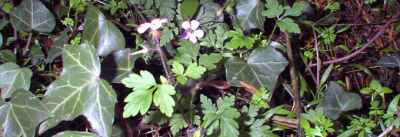Academic Year 2002-2003
Issues at Hendricks Park
Non-native, Invasive Plant Species
The forest under-story has been
significantly impacted by invasive and ornamental species from nearby
residential landscaping, and to some degree by seeds carried in on
clothing and dog fur by park visitors.
Other invasive species, like sweet cherry, have been introduced by birds in their droppings, or
by squirrels as food caches, and a few have blown in by wind.
Road-cuts and trails through the park provide conditions favoring
the spread of introduced species. Of
the 198 native and naturalized vascular plant species inventoried in
Hendricks Park, about 60% are native, and 40% have been introduced (i.e.,
escaped, naturalized, non-native species).
In this latter category, 20 species are considered „invasive.š

Invasives English Ivy (Hedera Helix) & Herb Robert (Geranium
Robertianum)
In recent years a number of seemingly healthy Douglas-fir trees fell
during wind storms. These incidents and other issues raised concerns about
the health of the
![]() Issues at Hendricks Park
Issues at Hendricks Park
![]() Project Objectives
Project Objectives
![]() Project Task List
Project Task List
Project Development
![]() Educational Plant
Guide
Educational Plant
Guide
![]() Invasive Species Monitoring
Invasive Species Monitoring
![]() Treatment Study
Treatment Study
![]() Encroachment Study
Encroachment Study
![]() Forest Inventory
Update
Forest Inventory
Update
![]() Plot Photo
Database
Plot Photo
Database
![]() Data Analysis
Data Analysis
![]() Misc. Project
Photos
Misc. Project
Photos
![]() Reference Sites
Reference Sites
Fall Term Presentation
Winter Term Presentation
Final Presentation
![]() Online MS PowerPoint presentations work best with
Internet Explorer 4.0 or newer.
Online MS PowerPoint presentations work best with
Internet Explorer 4.0 or newer.
